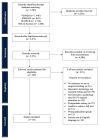A Systematic Scoping Review of the Current Applications of Digital Technology in Undergraduate Surgical Education
- PMID: 39801700
- PMCID: PMC11725316
- DOI: 10.7759/cureus.77278
A Systematic Scoping Review of the Current Applications of Digital Technology in Undergraduate Surgical Education
Abstract
Over the past few decades, technological advancements have established digital tools as an indispensable pedagogical resource in the realm of modern education. In the field of medical education, there is growing interest in how these digital tools can be effectively integrated to enhance undergraduate surgical education. However, despite their well-documented potential benefits, research specifically investigating the current use of digital technology in undergraduate surgical education remains limited, highlighting a critical gap in the existing literature. To address this research gap, this scoping review aims to elucidate the current utilisation of digital technologies in undergraduate surgical education by addressing the research question: 'How are digital technologies currently being utilised in undergraduate surgical education to meet surgical learning outcomes'. A scoping review was performed, adopting the Joanna Briggs Institute (JBI) framework. A comprehensive search strategy was conducted using the search terms 'technology' OR 'simulation' OR 'virtual reality' OR 'augmented reality' OR 'digital' OR 'online' AND 'undergraduate' AND 'surgical' on multiple electronic bibliographic databases including PubMed, Medline, ERIC, Embase, Scopus and Web of Science. These search terms were executed using both free-text and MeSH terms, with search terms combined using Boolean operators to ensure all relevant citations were captured. All search results were screened against the eligibility criteria using Covidence, a web-based software platform, using a two-stage process. Subsequently, all included studies were reviewed, and the extracted data was systematically sorted and organised, with the findings presented graphically accompanied by descriptive narratives. A thematic analysis was also performed to identify themes within the data to synthesise key findings. This scoping review revealed three key findings. First, the use of digital tools in surgical education has been steadily increasing over the past few decades, with the COVID-19 pandemic accelerating the integration of technology into surgical education. Second, this review also highlighted the key role of anatomy within surgical education, with most included studies reporting the use of digital technologies to enhance anatomy teaching. Finally, this review provided an overview of various digital tools used in surgical education and their associated user experiences. Overall, most studies indicated that digital technologies are well-received by students, with many advocating for their continued use in supplementing surgical education even beyond the pandemic. This review provides a crucial foundation for understanding the evolving role of digital innovations in shaping undergraduate surgical education. To enhance undergraduate surgical education, integrating appropriate digital learning tools can provide more learner-centred and personalised learning experiences. Educators must recognise that there is no 'one-size-fits-all' approach, and a flexible multimodal strategy is necessary to meet diverse learning needs. As technology continues to evolve and its role in education grows, this review offers valuable insights into the current use of digital tools in surgical education, highlighting opportunities for improvement and innovation to further enhance undergraduate surgical experience.
Keywords: digital; education; learning; surgery; technology.
Copyright © 2025, Quek et al.
Conflict of interest statement
Conflicts of interest: In compliance with the ICMJE uniform disclosure form, all authors declare the following: Payment/services info: All authors have declared that no financial support was received from any organization for the submitted work. Financial relationships: All authors have declared that they have no financial relationships at present or within the previous three years with any organizations that might have an interest in the submitted work. Other relationships: All authors have declared that there are no other relationships or activities that could appear to have influenced the submitted work.
Figures











References
-
- The preparedness of newly qualified doctors - Views of foundation doctors and supervisors. Kellett J, Papageorgiou A, Cavenagh P, Salter C, Miles S, Leinster SJ. Med Teach. 2015;37:949–954. - PubMed
Publication types
LinkOut - more resources
Full Text Sources
Research Materials
Miscellaneous
